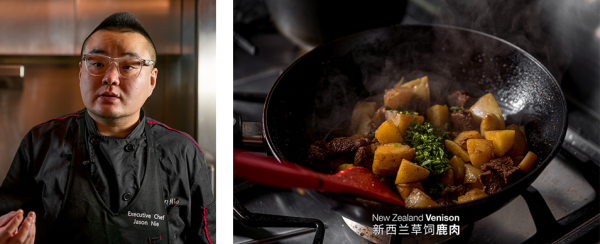Dec 16, 2021
Average prices to venison producers have been holding during December and are sitting about $1.50 a kilogram above where they were at the same time last year.
Marketers and Deer Industry NZ (DINZ) are increasingly confident that the market recovery is underway and that returns to producers will continue to increase during 2022.

Chef Jason Nie and a dish he created using NZ venison. The development of venison cuts and recipes specifically for Chinese cuisine styles has led to a big growth in sales of venison to China
Venison, which is largely sold to restaurants, was particularly hard-hit by lockdowns in response to Covid in Europe and the United States. With sales to restaurants constrained, prices fell and stocks built through 2020. As restaurants have reopened in 2021, these stocks have cleared, paving the way for a more positive 2022.
DINZ chief executive Innes Moffat says the industry has been watching with concern the return of restrictions in Europe and North America in response to a surge of infections caused by the omicron variant, but these do not appear to be significantly affecting demand.
“Internationally there’s less appetite for hard lockdowns. It’s more a case of diners and hospitality outlets being encouraged to take appropriate precautions, as well as an acceleration of the roll-outs of vaccine boosters. Everyone wants life to get back to being as normal as possible, eating out and so-on, regardless of the pandemic,” he says.
The recovery of venison prices has taken longer than it has for other export proteins. There are two main reasons for this. China, which is still recovering from an epidemic of African swine fever in its pork industry, has proved to be an eager buyer of lamb and mutton – a traditional meat in the north and west of the country. Venison does not have this traditional demand.
Lamb and beef, being more common meats, also have a permanent place in retail in North America. With restaurants shut in the USA, retail meat sales boomed, again, a position that venison did not have, so could not capitalise on.
“Both of these issues have been addressed by the industry in the last 18 months, with on-line and retail sales of venison in the United States growing rapidly from a low base. Significant demand has also been created in China, with the development of recipes and cuts that fit with Chinese cuisine,” Moffat says.
“Having a strong presence in China and at retail in the United States, as well as the traditional European and US food-service markets, is strategically important. If these new markets are sustained the industry will be much less vulnerable in the future to down-turns in any one market or market segment.”
Nevertheless, demand during the European game season – when prices to farmers typically peak – will remain important.
“Early discussions between marketers and their overseas customers strongly point to prices to farmers during the coming autumn to continue to track above 2021 levels, before peaking in spring during the game season,” he says.
Moffat says it’s pretty hard to predict spring prices this far in advance. “None of us control the currency, Covid, shipping rates or port closures -- all of these things continue to confound the smooth operation of international trade and create uncertainties about the year ahead.
“What we collectively can do is build a greater diversity of markets and to create marketing programmes that strike a chord with potential customers for our wonderful NZ venison. That’s exactly what the industry has been doing over the past 18 months.
“It is very heartening to see many of these initiatives starting to bear fruit and to see this being reflected in a firming of prices to farmers.”

